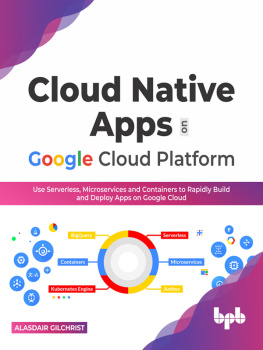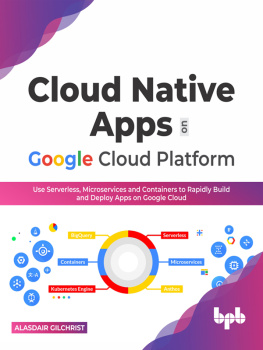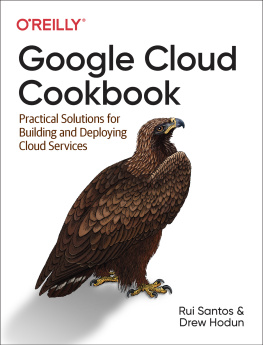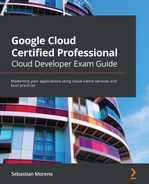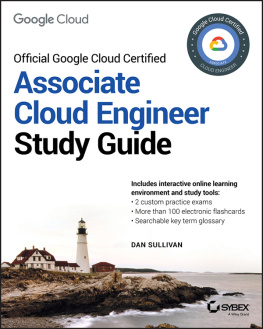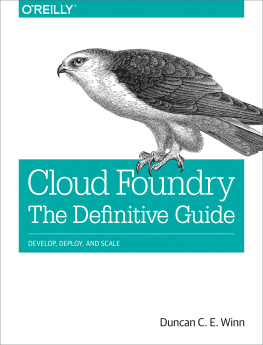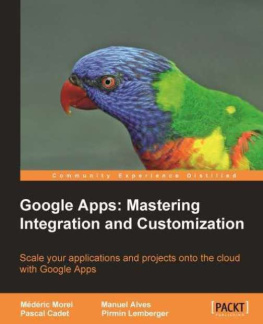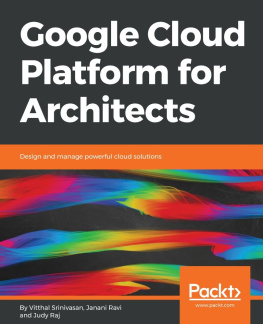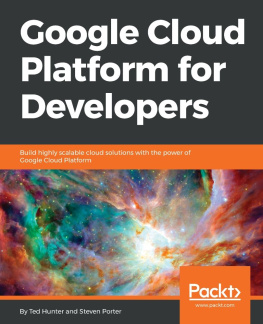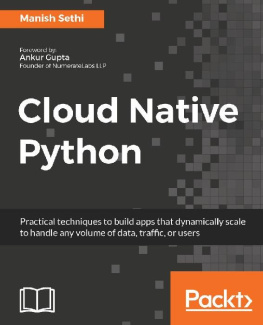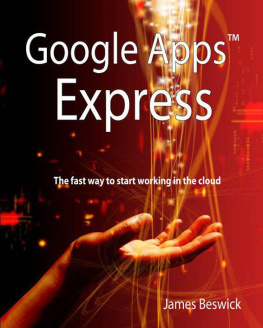Gilchrist Alasdair - Cloud Native Apps on Google Cloud Platform
Here you can read online Gilchrist Alasdair - Cloud Native Apps on Google Cloud Platform full text of the book (entire story) in english for free. Download pdf and epub, get meaning, cover and reviews about this ebook. year: 2022, publisher: BPB Publications, genre: Computer. Description of the work, (preface) as well as reviews are available. Best literature library LitArk.com created for fans of good reading and offers a wide selection of genres:
Romance novel
Science fiction
Adventure
Detective
Science
History
Home and family
Prose
Art
Politics
Computer
Non-fiction
Religion
Business
Children
Humor
Choose a favorite category and find really read worthwhile books. Enjoy immersion in the world of imagination, feel the emotions of the characters or learn something new for yourself, make an fascinating discovery.
- Book:Cloud Native Apps on Google Cloud Platform
- Author:
- Publisher:BPB Publications
- Genre:
- Year:2022
- Rating:5 / 5
- Favourites:Add to favourites
- Your mark:
- 100
- 1
- 2
- 3
- 4
- 5
Cloud Native Apps on Google Cloud Platform: summary, description and annotation
We offer to read an annotation, description, summary or preface (depends on what the author of the book "Cloud Native Apps on Google Cloud Platform" wrote himself). If you haven't found the necessary information about the book — write in the comments, we will try to find it.
Cloud Native Apps on Google Cloud Platform — read online for free the complete book (whole text) full work
Below is the text of the book, divided by pages. System saving the place of the last page read, allows you to conveniently read the book "Cloud Native Apps on Google Cloud Platform" online for free, without having to search again every time where you left off. Put a bookmark, and you can go to the page where you finished reading at any time.
Font size:
Interval:
Bookmark:

Native Apps on
Cloud Platform

Rapidly Build and Deploy Apps on Google Cloud


www.bpbonline.com
FIRST EDITION 2022
Copyright BPB Publications, India
ISBN: 978-93-55511-232
All Rights Reserved. No part of this publication may be reproduced, distributed or transmitted in any form or by any means or stored in a database or retrieval system, without the prior written permission of the publisher with the exception to the program listings which may be entered, stored and executed in a computer system, but they can not be reproduced by the means of publication, photocopy, recording, or by any electronic and mechanical means.
LIMITS OF LIABILITY AND DISCLAIMER OF WARRANTY
The information contained in this book is true to correct and the best of authors and publishers knowledge. The author has made every effort to ensure the accuracy of these publications, but publisher cannot be held responsible for any loss or damage arising from any information in this book.
All trademarks referred to in the book are acknowledged as properties of their respective owners but BPB Publications cannot guarantee the accuracy of this information.

www.bpbonline.com
Alasdair Gilchrist is an industry veteran of over 25 years spent in IT, Security, Networking, Mobile Telecoms and lately in Cloud Computing. He is the author of many technical books spanning IT, Google Cloud Platform and Industrial technologies, such as Industry 4.0 and the Industrial Internet of Things. Currently he works full-time as a Google Cloud Architect and part-time as a technical author.
Gopinath Balakrishshnan is a Cloud advisor/Architect, Technical Advisory Board member of a startup, Advisory Council member of California State University, Chico, CA, member of Harvard Business Review Advisory Council, Judge panel for Stevie and CODiE awards, Director of Technical Steering Committee, Moja Global.
Specialized in product engineering, distributed systems/cloud platforms, built/managed high performance teams , led large transformation programs. Sales driven system engineering/solution architecting roles, worked with medium/large enterprises for their new application/infrastructure design, delivered proof-of-concept/pilots, engaged with several C level leaders at early stage startups (Series B to D) and built technology partnerships, support their digital transformation journey and help solve their business and technology challenges by helping build/migrate/modernize the application/infrastructure that can scale with better economics and resilient using Google cloud solutions with a cloud native approach.
Adnan Ahmed Khan has 7 years of experience in Software Development, System Design and Automation. He has been a practitioner of Cloud Technologies from Google and AWS. Adnan has pursued MSc. in Computer Science from the American International University of Bangladesh. He has worked with startups like G&R, Pathao and Deligram. He is currently working as a Software Developer in Red.Digital Limited, Dhaka. His day to day life involves design, development and managing cloud-native applications.
I would first like to start with thanking BPB for giving me the opportunity to write this book. But writing the book is a team effort so I would like to thank my team mates.
A huge thank you to my editor for her patience, diligence and professionalism when editing the book. (It could never have been done without you SB).
I also need to thank Mr. Gopinath and Mr. Adnan who worked as the technical reviewers everything they so professionally contributed was a huge value add to the book.
Thank you all at BPB and I hope you the reader enjoy the book.
The purpose of this book is to demonstrate how to design develop and deploy cloud native apps on the Google Cloud Platform. The book is designed to provide theoretical lessons reinforced by step-by-step hands-on tutorials. The value of this approach is that after reading the book you will know why, where and when to use cloud native applications but most importantly you will also know how to build, test and deploy your own cloud native apps on the Google Cloud Platform.
Applications that are designed, developed and deployed by leveraging cloud-based technologies are known as Cloud-Native Applications. Cloud Native apps are built, tested and run using all the advantages of the cloud computing delivery model. However, the term, cloud native application, is not just another buzz-word as these applications have a real design purpose, which is to succeed in todays fast-paced and competitive software market. As a result, cloud native applications aim to revolutionize software delivery by simultaneously leveraging cloud platform tools, techniques, and technologies whilst also supporting cloud platform operations and DevOps capabilities.
What makes cloud native applications different from traditional web apps is that to be successful in application development today we need to speed up building new applications, optimize existing ones, and find ways to rapidly deploy them into production. Minimizing the time getting the product to market and to profit is critical in business. To this end organizations have developed operational and development strategies that involves methodologies such as DevOps and Agile development, that utilize cloud platform architectures to ensure high quality whilst also delivering continuous improvement and rapid deployment. Devops delivers the functions of continuous integration and continuous deployment pipelines (CI/CD). This is the technique used in DevOps for automated delivery of the product into production.
Cloud native apps are typically designed around microservices, which amongst their other benefits allow you to create, maintain, improve or scale one component of an application without having to refactor the whole application. Microservices are typically deployed in containers, as this provides mobility through the write once and deploy anywhere, design model as containerized apps can run on any cloud platform. For scalability, resiliency and performance the containers are typically run in Kubernetes clusters, which is a container orchestrator and cluster manager.
The cumulative effect of leveraging these techniques and methods in cloud native application development means that the apps can bring tangible value to the organization by delivering products that users need at the pace the business demands.
Over the 13 Chapters of this book you will learn the following:
In this chapter we describe what a cloud native application is and lists its characteristics. You will learn about the modern concepts of Devops and the CI/CD process in particular. We discuss the Google Cloud Platform service model and you will understand the difference between each offered service. Also, through practical hands on learning you will be able to deploy a sample application to Cloud Functions, Google App Engine, and Cloud Run.
Font size:
Interval:
Bookmark:
Similar books «Cloud Native Apps on Google Cloud Platform»
Look at similar books to Cloud Native Apps on Google Cloud Platform. We have selected literature similar in name and meaning in the hope of providing readers with more options to find new, interesting, not yet read works.
Discussion, reviews of the book Cloud Native Apps on Google Cloud Platform and just readers' own opinions. Leave your comments, write what you think about the work, its meaning or the main characters. Specify what exactly you liked and what you didn't like, and why you think so.

